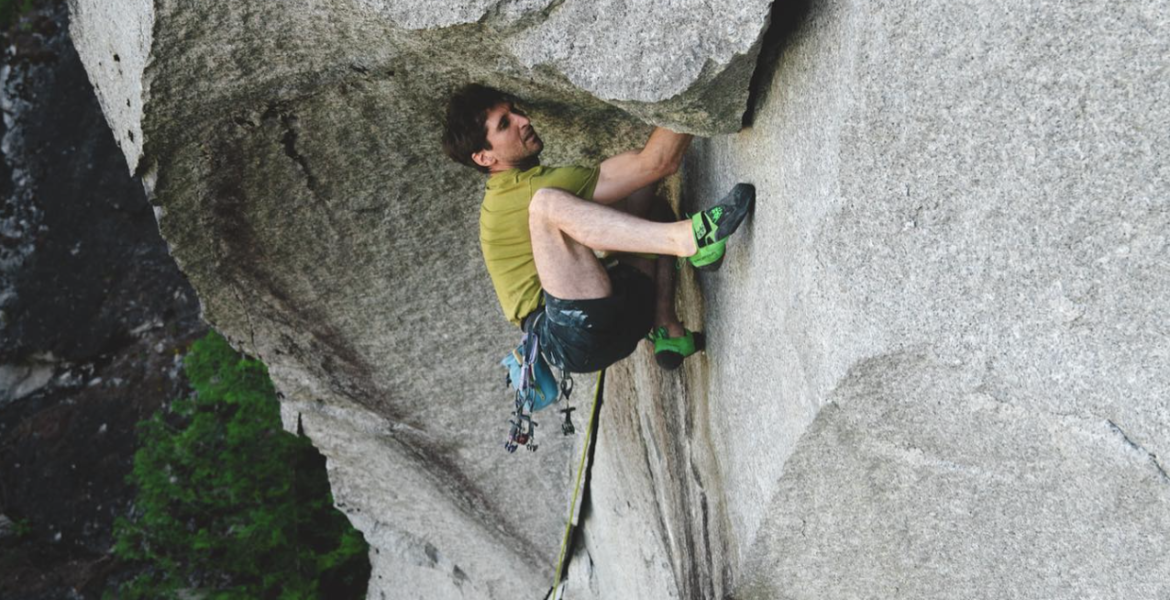Dernièrement, des ascensions extrêmes en trad ont eu lieu à Squamish au Canada, on vous en fait écho !
*** Ben Harnden répète « Crack of Destiny » : un des grimpeurs locaux de Squamish et expert en trad vient de réaliser une répétition (3ème ascension) de la fissure de « Crack of Destiny », ouverte par l’inévitable Didier Berthod l’été dernier. Cette fissure, qui offre une escalade pure dans le style, toute en verrous et pieds à plat, est nichée au secteur The Chief, non loin de la célébrissime « Cobra crack ». Elle avait été jugée par Berthod sensiblement du même niveau (8b+). La voie avait aussi été répétée par le jeune Connor Herson (21 ans) l’an dernier.
*** Connor Herson et Didier Berthod libèrent « The Shark » : Les deux derniers cités ne sont pas en reste, la légende Suisse Didier Berthod annonçant une ascension de son projet du moment « The Shark », quelques semaines après la première ascension par Connor Herson. Berthod avait invité le jeune talent californien à essayer le projet avec lui. Le grimpeur suisse annonce que la difficulté de la voie est du même niveau que « Cobra Crack » et « Crack of Destiny ». Il la décrit de la sorte :
« L’itinéraire est situé sur le Chief à Squamish. Il se trouve dans le secteur du Grand Wall, au bout de trois longueurs. Il s’agit d’une fissure de 20 mètres de long qui traverse une arche très raide. Elle commence par une sorte d’escalade en mur protégée par trois spits avant d’atteindre la fissure. Au début, c’est une fissure de la taille d’un doigt qui s’ouvre ensuite pour devenir plus large. Sur cette section, il y a une rampe à droite pour les pieds, ce qui aide beaucoup. Après cette première section, il y a un repos, puis commence une section en opposition super cool avec de mauvais pieds. À un moment donné, il y a quelques verrous avec les mains et les poings, puis un nouveau repos. La dernière section est un mélange de verrous de doigts, de mains et un mouvement en opposition avec la fissure qui constitue le crux.
Quelles sont les différences entre ces 3 fissures, « Cobra crack », « Destiny » et « The Shark » ?
« Crack of Destiny » et « Cobra » sont des fissures à doigts classiques, jusqu’au sommet. « Cobra » est plus un défi de rési car la section dure ne fait que 13 mouvements; « Destiny » est plus long, environ 30+ mouvements dans la fissure. Mais le « Shark » est un mélange sympa de différents types de fissures, des doigts au poing (il y a même un coincement de coude au début !). Elle est aussi beaucoup plus raide que les deux autres, et à cet égard le type d’escalade est très proche d’une voie d’escalade sportive très raide. Et l’effort serait plus proche d’une voie d’endurance que d’un défi de rési.

A number of extreme trad climbs have recently been ticked in Squamish, Canada, and we’d like to tell you all about them!
*** Ben Harnden repeats ‘Crack of Destiny’: one of Squamish’s local climbers and a trad expert has just completed a repeat (3rd ascent) of ‘Crack of Destiny’, freed by the inevitable Didier Berthod last summer. This crack, which delivers crack climbing of the purest style, all locks and smears, is nestled in The Chief sector, not far from the famous ‘Cobra crack’. Berthod judged both to be of a similar level (8b+). The route was also repeated by young Connor Herson (21) last year.
*** Connor Herson and Didier Berthod free ‘The Shark’: The last two mentioned are not to be outdone, with Swiss legend Didier Berthod announcing the send of his current project ‘The Shark’, a few weeks after Connor Herson’s first ascent. Berthod had invited the young Californian talent to try out the project with him. The Swiss climber announced that the difficulty of the route was on a par with ‘Cobra Crack’ and ‘Crack of Destiny’. He describes it as follows:
« The route is located in the Chief in Squamish. Its on the Grand Wall area, three pitches up the wall. It’s a 20-meter long crack that traverses a super steep arch. It starts with some kind of face climbing protected by three bolts and then reaches the crack. At the beginning it’s a finger-sized crack that opens up to baggy fingers. On this section there is a ramp on the right for your feet and that helps a lot. After this first section you have a rest, and then starts a super cool layback section with poor feet. At some point you can have some hand and fist jams, and then reach a second rest. The last section is a mix of finger jam, hand jam and a cruxy layback move.
What are the differences between these 3 cracks, ‘Cobra crack’, ‘Destiny’ and ‘The Shark’?
‘Crack of Destiny’ and ‘Cobra’ are kinda classic finger cracks, all the way to the top. Cobra is more a power endurance challenge because the hard section is only 13 moves, ‘Destiny’ is longer, around 30 + moves in the crack. But the ‘Shark’ is a cool mix of plenty of different types of jamming, from finger to fist (there is even one chicken wing at the beginning!). Its also way steeper than the other two, and in this regard the type of climbing is very close to a very steep sport climbing route. And the effort would be more like an endurance route than a power endurance challenge.



